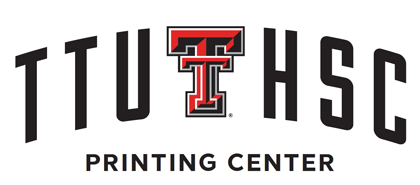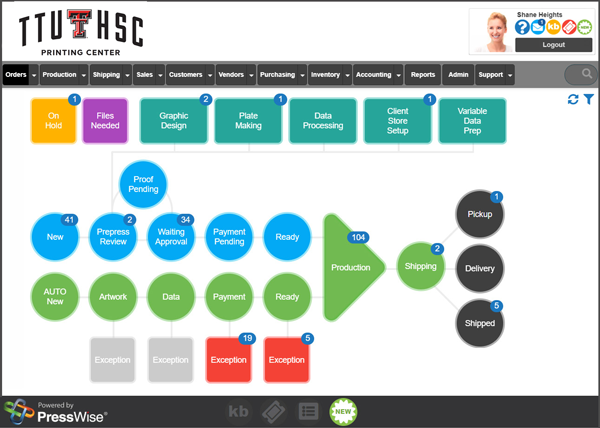 Arthur Paré, Assistant Managing Director for General Services at the Texas Tech University Health Sciences Center (TTUHSC), is quick to point out that in-plant print operations are not always considered essential parts of the parent organization. At TTUHSC though, Paré’s in-plant runs the way more in-plants should.
Arthur Paré, Assistant Managing Director for General Services at the Texas Tech University Health Sciences Center (TTUHSC), is quick to point out that in-plant print operations are not always considered essential parts of the parent organization. At TTUHSC though, Paré’s in-plant runs the way more in-plants should.
One of the most visible differences is that the shop is able to review all printing purchase orders before they are entered and can counter with their quote, which procurement almost always accepts.
At TTUHSC each potential job is reviewed by the in-plant team to see how it may fit into the schedule and if it does, whether the shop can do the job efficiently and on schedule. This is in stark contrast to jobs in countless organizations that never see the inside of their local in-plant. The TTUHSC rule not only drives more print work to the shop, it ensures the spend meets all identity guidelines, and that the organization gets the best value for its money.
An Efficiency Driver
This strategy means more jobs of all sizes and descriptions land on the presses of the print shop, driving a need to process them quickly, accurately—and profitably. At TTUHSC the tool of choice is PressWise, a powerful SaaS print MIS from SmartSoft. Paré says PressWise is especially good for in-plants, especially ones that rely on cost recovery for some or all of their jobs.
 For Paré and his team a big plus is that PressWise could be tightly integrated with the university’s accounting systems, simplifying cost tracking and control. With some 631 departments spread over five universities in multiple locations across Texas keeping track of printing costs is not a trivial matter.
For Paré and his team a big plus is that PressWise could be tightly integrated with the university’s accounting systems, simplifying cost tracking and control. With some 631 departments spread over five universities in multiple locations across Texas keeping track of printing costs is not a trivial matter.
“Each department is a customer,” explains Paré. “so we have to know each department’s exact spend and the types of jobs they run.” Before PressWise it was hard to tell whether jobs were charged correctly and sometimes even if the charges went to the right department.
The automated job submission process that kicks this off results in creation of an accurate job ticket that accompanies each job as it progresses through the plant. For example, someone in the physics department seeking to submit a job through the university’s computer network first sees a PressWise -driven digital “storefront” customized for their department.
A job ticket for each job submitted is put into the schedule, pre-flighted, and all the job specs are attended to: layout, paper and cover stocks, type of binding, quantity, distribution requirements, departmental branding, and so on. From receipt through printing, a job may be untouched by human hands, but its status is readily available for Paré’s team to see. The result is faster, more accurate printing with little or no human intervention. This speeds throughput and helps control costs.

Inventory Control
PressWise has become especially beneficial in managing the many moving parts of inventory control. As in most print shops, keeping track of stock levels can be an ongoing challenge. Once stock levels are entered into PressWise, production managers and machine operators are able to tell whether there is enough stock on hand to complete a job as well as how much is left after each job is completed. This is especially important for jobs requiring specialized or preprinted materials because no print shop wants to find themselves 11,026 pre-printed sheets short of what a job requires. With PressWise, the exact quantities each job uses (including waste) are tracked so the amounts available are known before the next job is run. In addition, the system can be configured to help maintain inventory levels so materials can be re-ordered based on usage and stocking levels.
Thirty Days
Paré says most of the 20 or so people working in his shop had never worked with an automated Print MIS before or experienced the power of a digital storefront. This lack of experience turned out to be a non-issue. “They were able to be up and running with PressWise in about 30 days,” recounts Paré. “Getting all 631 departments on board took a couple of years because they all had specific and often unique needs but there was almost no pushback from any customers. And we were able to keep pricing the same for most items while saving time and labor costs.”
Still the transition was not without some pushback. While some shops experience resistance from equipment operators or production managers, Paré heard from his designers. They felt the system would reduce the amount of work they would do, especially departmental business cards which were shifting to using a series of templates. With PressWise though, designer time was freed up and they were able to shift from being primarily typesetters to being graphic designers where their creativity and skills were more valuable.

All the Way to the Truck
After every print run is complete there is still shipping. PressWise “knows” how many pages are in say, each document and what they weigh. This information is compiled for each job and translated into the total shipping weight based on its destination, yielding costs for USPS, FedEx, UPS and other carriers. Jobs can also be split into multiple shipments when it is more efficient.
Moreover, the business rules driving this can be adjusted as needed at any time.
Yet not everyone is a fan. There are people in some departments still want to do things the old way, even though it may be slower and less efficient. “Part of being an in-plant is that we can give special service,” says Paré. “We do what they ask while trying to educate them on the advantages PressWise offers. For example, many jobs a department may send in are for the same or similar products. Having the PressWise job history helps us the next time a department submits a similar job while also making it easier for the customer.”
Another advantage Paré sees both inside his in-plant and within the departments is the decreasing number of touchpoints which further streamline the workflow; “We have to turn jobs fast,” he notes. “We’ve always been a short-run shop, nothing over 20,000 copies, with most in the 4,000 to 10,000 range. With such short runs we need efficiency and automation and that is what we get using PressWise.”
